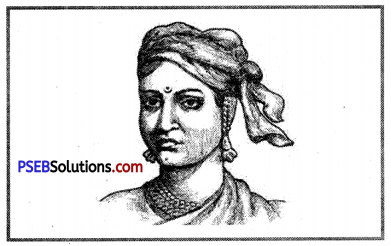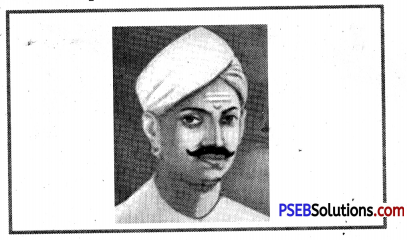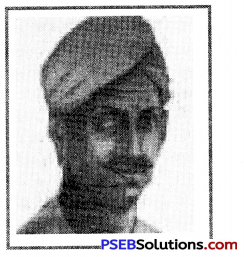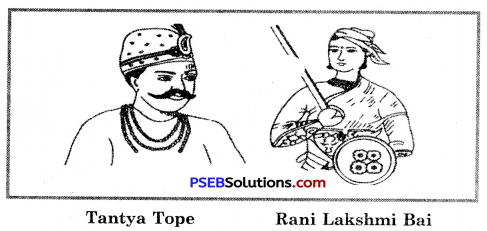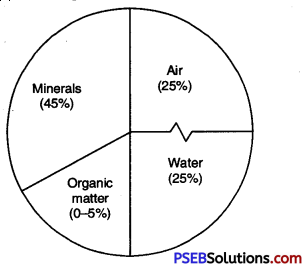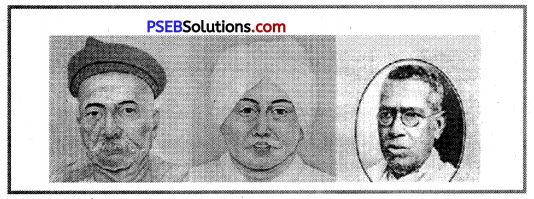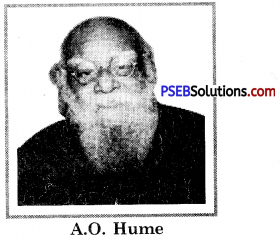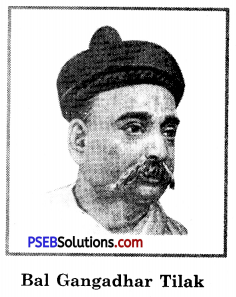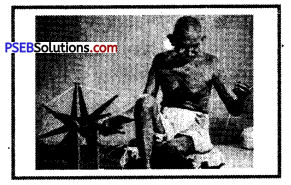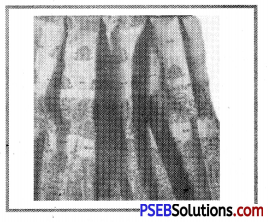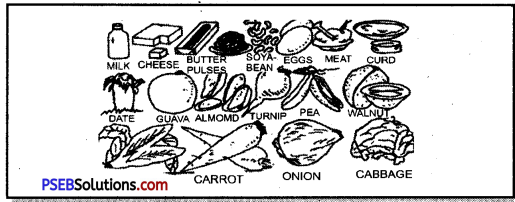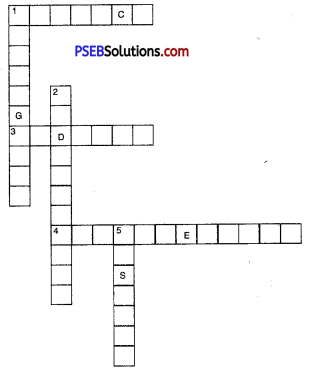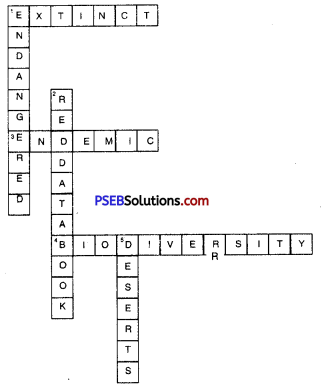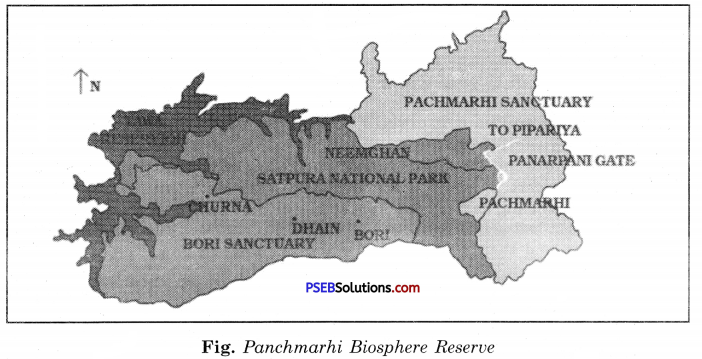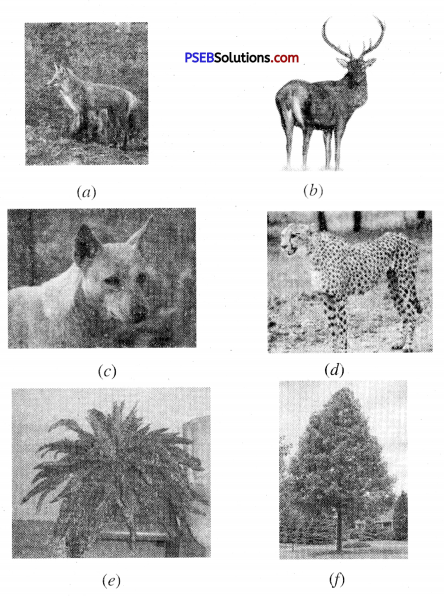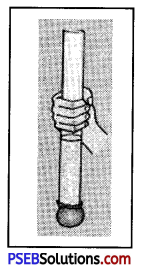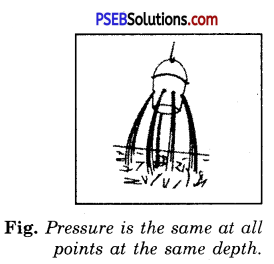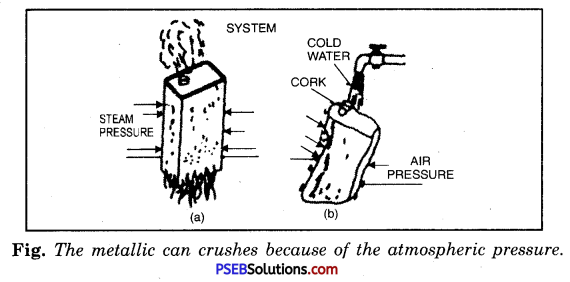Punjab State Board PSEB 8th Class Social Science Book Solutions History Chapter 22 National Movement 1919-1947 A.D. Textbook Exercise Questions and Answers.
PSEB Solutions for Class 8 Social Science History Chapter 22 National Movement 1919-1947 A.D.
SST Guide for Class 8 PSEB National Movement 1919-1947 A.D. Textbook Questions and Answers
I. Answer the following questions:
Question 1.
When and from which country Mahatma Gandhiji came back to India?
Answer:
Mahatma Gandhiji came back in 1891 A.D. from England and then again came back to India from South Africa in 1915 A.D.
Question 2.
What do you mean by Satyagraha Movement?
Answer:
Satyagraha was one of the largest weapons of Mahatma Gandhi. According to it, he used to keep fast or to set on protest. Many a time he used to keep hunger strike.
Question 3.
Where and when Jallianwala Bagh tragedy occurred?
Answer:
Massacre of Jallianwala Bagh took place on 13th April 1919 A.D. at Amritsar.

Question 4.
What do you mean by Khilafat Movement?
Answer:
Indian Muslims believed that the Sultan of Turkey was their Khalifa and religious leader. He was not treated well by the British after the First World War. That’s why Muslims started a movement against the British which was known as Khilafat movement.
Question 5.
Write down the names of the persons who left their law practices during the non-cooperation.
Answer:
Moti Lai Nehru, Dr. Rajendra Prasad, C.R. Dass, Sardar Patel, Lala Lajpat Rai, etc.
Question 6.
When and why Simon Commission was appointed?
Answer:
Simon Commission was appointed in 1928 A.D. to check the Reform Act of 1919 A.D.
Question 7.
When and where, by whom was founded the Nau-Jawan Bharat Sabha?
Answer:
Nau-Jawan Bharat Sabha was founded by Sardar Bhagat Singh, Rajguru, Sukhdev and Bhagwati Charan Vohra at Lahore in 1926 A.D.
Question 8.
Write down a note on Simon Commission.
Or
What do you know about Simon Commission?
Answer:
The British government appointed Simon Commission and sent it to India in 1928 A.D. to check the Reform Act of 1919. This Commisson had seven members but none of them was an Indian. So this commission was strongly opposed with black flags and slogans like ‘Simon go back’. Police started canning the revolutionaries. As a result Lala Lajpat Rai got hurt in this canning and later on he died because of these wounds.
Question 9.
Write down a note on civil disobedience movement. .
Answer:
Mahatma Gandhi started Civil Disobedience Movement in 1930-1934 A.D. to attain freedom from the British. He broke the Salt Law at a place named Dandi on the coast of Gujarat. Encouraged by this incident, people of all the coastal areas started violating the Salt Law. A pact was signed between Gandhiji and Lord Irwin in 1931 A.D. All those who had violated the law were freed. Gandhiji went to England to participate in the Second Round Table Conference. But no satisfactory solution to the Indian problems could be found there. ^On his return from England, Gandhiji again started the Civil Disobedience Movement. Gandhiji was arrested and sent to jail. Government declared Indian National Congress illegal to suppress this movement and leaders of Congress were sent to jail. Police fired at people at many places. But the British government was unable to suppress this movement.

Question 10.
Write down a note on Quit India Movement.
Answer:
The British fought Second World War against Japan. So Japan decided to attack India because India was under the British rule. Gandhiji thought.that if the British could left India then Japan would not attack India. So Gandhiji started Quit India Movement on 8th August 1942 A.D. Government arrested Gandhiji and other Congress leaders on 9th August 1942 A.D. People got angry with this and they severely damaged police stations, government buildings, post offices and railway stations. Government also used repressive policies but was unable to suppress the revolutionaries.
im-1
Question 11.
Write down a note on Azad Hind Fauj.
Answer:
Indian National Army was founded by Subhash Chandra Bose in Japan. His objective was to free India from the British rule. Those Indian soldiers were included in Indian National Army who were captivated during the Second World War by Japan. Subhash Chandra Bose gave many slogans such as ‘Delhi Chalo’, ‘Give me blood, I will give you freedom’, ‘Jai Hind’ etc. But Japan was defeated in Second World War. So Indian National Army was unsuccessful in getting India free. Subhash Chandra Bose died in an air crash in 1945 A.D. A number of soldiers of Indian National Army were arrested by the British. That’s why Indian people did strikes, protest and demonstrate in whole of the country. So the British made free all the soldiers of Indian National Army.
Question 12.
Explain the Gandhian Era.
Answer:
Mahatma Gandhi holds the highest place in the history of modern India. He made the maximum contribution to the freedom struggle of India. He faced the British with Non-violence and Satyagraha and forced them to leave India.
A brief description of the life and activities of this great freedom fighter is as under :
Birth and Education: Gandhiji’s name was Mohan Das Karam Chand Gandhi. He was born on 2nd Oct., 1869 A.D. at Porbander in Kathiawar. Gandhiji received his early education in India and went to England for his higher education. He became a barrister and came back to India.
Political Life: After returning from England, he worked as lawyer for some time. But later, he went to South Africa.
When he reached South Africa, he was pained to see that the Indians were not treated well by the whites. Gandhiji could not tolerate it. He started Satyagraha movement there and helped Indians to get their demands accepted by the African Government.
Gandhiji in India: In 1915, Gandhiji returned to India from South Africa. The First World War was going on at that time. The British Government was engaged in this war. It was badly in need of men and money. So, Gandhiji appealed to the people to cooperate with the British. He wanted to win over the British by helping them. He believed that the British would grant freedom to India after winning the war.
im-2
But contrary to his belief, the British passed the Rowlatt Act. Gandhiji was very much pained by these Black Bills and he started satyagraha against them.
Non-Cooperation Movement: Gandhiji started the Non-Cooperation Movement against the British in 1920. Public completely cooperated with Mahatma Gandhi. The government tried to suprress the movement forcefully. But Gandhiji withdrew the movement on account of some incident of violence in 1922.
Civil Disobedience Movement: In 1930, Gandhiji started Civil Disobedience Movement. He violated salt laws by preparing salt from sea water. He broke the salt law on the sea coast at Dandi in Gujarat in March, 1930. The people started defying the salt laws at various places. Consequently, the government was frustrated and Indians were given the right to prepare salt.
Quit India Movement. The main aim of Gandhiji was to free India. He started Quit India Movement in 1942 to achieve his aim. Lakhs of people took part in the movement and suffered heavy losses. Though the movement failed, yet it made clear that the British would have to quit India soon.
Other Works: Gandhiji did a lot to uplift the status of all the Indians. He gave the message of wearing Khadi to remove poverty from India. He gave the message of brotherhood to stop communal riots in the country.
Death: On 30th January, 1948 A.D. Gandhiji was shot dead by Nathu Ram Vinayak Godesey. The whole of the country was plunged into gloom at his death. Indians cannot forget the services of Gandhiji. He is remembered as the ‘Father of the Nation’.

Question 13.
Explain the Non-Cooperation Movement launched by Mahatma Gandhi.
Answer:
Mahatma Gandhi started Non-Cooperation movement against British Government in 1920 A.D.
Following were the main objectives of this movement :
- To criticize the atrocities committed on people of Punjab and the policies of British.
- To stop injustice committed against Sultan of Turkey (Khalifa)
- To establish unity among Hindus and Muslims.
- To achieve Swaraj (freedom) from British Government.
Program of Non-Cooperation Movement :
- To give up government jobs.
- To return government or official titles.
- Not to take part in government festivals and meetings.
- Not to use foreign-made goods. Instead country-made goods should be used.
- To boycot government courts and disputes should be resolved through Panchayats.
- To use Khadi cloth made by charkha.
Progress of Non-Cooperation Movement: Mahatma Gandhi returned his title of ‘Kesar-e-Hind’ to the government. He appealed the people to take part in his movement. Many Indians gave up their government jobs and titles. Thousands of students left their schools and colleges. They started to study in Kashi Vidyapeeth, Gujarat Vidyapeeth, Tilak Vidyapeeth, etc. Hundreds of Lawyers left their legal practice. Moti Lai Nehru, Dr. Rajendra Prasad, C.R. Dass, Sardar Patel, Lala Lajpat Rai also left their legal practice. People sacrificed foreign made clothes and started tctuse Khadi clothes made by charkha.
Government arrested thousands of people to suppress this movement. Congress session was going on at village Chauri-Chaura of Gorakhpur distt. of Uttar Pradesh in 1922 A.D. Around 3000 farmers were taking part in it. Police fired bullets ut them. Farmers became angry, they attacked the police station and set it on fire. As a,result 22 policemen were killed. Gandhiji became furious he took back Non-Cooperation’Movement at Bardauli on 12th February in 1922 A.D.
Importance: Yet the Non-Cooperation Movement was called off by Mahatma Gandhi but still it gave an important contribution in spreading National movement.
- People of almost all the classes took part in this movement with which national consciousness occurred among them.
- Females also took part in it. Their self-confidence increased with this.
- Popularity of Congress party increased with this movement.
- Some leaders of Congress were furious with Mahatma Gandhi because of calling off the movement. Pandit Moti Lai Nehru and C.R. Dass were some of them. So they founded ‘Swaraj party’ on 1923 A.D. to achieve freedom from the British.

Question 14.
Explain the Revolutionary movement.
Answer:
Revolutionary movement was also started in India for getting freedom from the British rule. Their brief description is given below :
1. Babbar Akali Movement: Some Akali Sikh leaders wanted to run Gurudwara reform movement in a violent way. They were known as Babbar Akalis. Their leader Kishan Singh founded a ‘Chakravarti Jatha’ and raised his voice against repressive policies of British at Hoshiarpur and Jalandhar. He along with his 186 friends was arrested on 20th February 1923. Five out of them were hanged.
2. Young India Society (Naujawan Bharat Sabha): Young India Society was founded at Lahore in 1926 A.D. It’s founder members were Bhagat Singh, Rajguru, Bhagwaticharan Vohra, Sukhdev, etc.
Main Objectives: The following were the main objectives of this society :
- To deveop feeling of sacrifice.
- To develop sense of patriotism among the people.
- To spread revolutionary ideas among the masses.
Membership: All the males-females of 18 to 35 years of age were free to become members of this society. Only those persons could become members who believed in their programmes. Many males and females of Punjab gave their cooperation to this society. Durga Devi Vohra, Sushila Mohan, Amar Kaur, Parvati Devi and Lilawati were some of its members.
Activities: Members of this society were fully active at the time of arrival of Simon Commission. Revolutionaries took out strong procession against Simon Commission under the leadership of Lala Lajpat Rai. The British police caned that procession. Lala Lajpat Rai was severely hurt in this canning. He died on 17th November 1928 A.D. Meantime, all the revolutionaries of India made their central organization called ‘Indian Socialist Republic Association’. Members of Young India Society started to carry on activities with this association.
Assembly Bomb Case: Bhagat Singh and Batukeshwar Dutt surrendered themselves by throwing bombs in legislative assembly on 8th April 1929 A.D. Pobce also arrested two other revolutionaries—Sukhdev and Rajguru.
Bhagat Singh, Sukhdev and Rajguru were hanged on”23rd March 1931 A.D. on the charges of murder of Police officer Mr. Sanderas. But it is one of the hard facts that Bhagat Singh sacrificed his life and set an example which could motivate .the coming generations.
Question 15.
Explain about Gurudwara reforms movement.
Answer:
Gurudwara reform movement was started, during the period of 1920-1925 A.D., to remove occupation of Gurudwaras of Punjab from the clutches of Mahants. This movement is also known as Akali Movement because Akalis made possible to remove Mahants from Gurudwaras.
Akali Dal started many morchas for making Gurudwara reform movement successful. Brief description of some of these morchas is as below :
1. Morcha of Nankana Sahib. Mahant Narayan Dass of Nankana Sahib was a characterless person. One peaceful Jatha reached Nankana Sahib on 20 February 1921 A.D. to remove him from the Gurudwara. This Jatha was badly treated by Mahant. His goons attacked the Jatha. Leader of Jatha Laxman Singh and some of his supporters were burnt alive by the Mahant.
2. Morcha of Keys of Treasury of Harmandar Sahib. Keys of treasury of Harmandar Sahib were with the British. Shiromani Committee demanded those keys but British denied to hand over keys to them. Sikhs protested against British for their denial of handing over the keys. Many sikhs were arrested by the British. Congress and Khilafat Committee supported the British. So finally the British handed over the keys of treasury to the Shiromani Gurudwara Prabandhak Committee (S.G.P.C.)
3. Morcha of ‘Guru Ka Bagh’. Gurudwara ‘Guru Ka Bagh’ is situated in Ajnala sub¬division and around 13 miles from Amritsar. This Gurudwara was under possession of Mahant Sunder Dass who was a characterless person. Shiromani Committee sent a Jatha under the leadership of Daan Singh on 23rd August 1921 A.D. to take over the possession of this Gurudwara. Members of this Jatha were arrested by the British. Sikhs got furious with this. They started sending more and more Jathas to Gurudwara. These Jathas were also badly treated. Its members were even canned by the police.
4. Incident of Punja Sahib. The Government decided to send Sikhs arrested in ‘Guru Ka Bagh’ Morcha to Attock through railway. Sikhs of Punja Sahib urged the government to stop train at Hassan Abdal so that arrested Sikhs could be given food. But Government denied that request. Then Bhai Karan Singh and Bhai Pratap Singh jtood in front of train and got martyrdom. Except the martyrdom of these two Sikhs, body parts of many Sikhs were cut down.
5. Jaito Morcha. In 1923 A.D., the British dethroned Ripudaman Singh, the ruler of Nabha, without any reason. Shiromani Akali Dal and other patriot Sikhs decided to hold a big rally at Gurudwara Gangasar (Jaito). On 21st February, 1924 A.D. a Jatha of five hundred Akalis started for Gurudwara Gangasar. They had to face British army when they reached Nabha. The Sikhs were unarmed. Consequently, more than 100 Sikhs achieved martyrdom and about 200 were injured.
6. Sikh Gurudwara Act. In 1925 A.D., the Punjab Government passed the Sikh Gurudwara Act. According to this Act, the management of the Gurudwaras came into the hands of the Sikhs and the government released all the Sikhs from the jails in due course of time.
So, the Sikhs made many sacrifices in the Akali movement. On the one hand, they saved the Gurudwaras from the Mahants who were puppets in the hands of the British and on the other hand, they created a spirit of hatred among the Indians against the British which continued till the achievement of independence.
II. Fill in the Blanks :
Question 1.
Mahatma Gandhi started ____________ movement in India against the Rowlatt Act.
Answer:
Non Cooperation
Question 2.
Mahatma Gandhi ji postponed the Non-Cooperation in ____________________
Answer:
1922 A.D

Question 3.
Nankana Sahib Gurdwara’s Mahant _________________ was characterless person.
Answer:
Narayan Das
Question 4.
There were ____________ members of Simon Commission, which was sent in India in 1928 A.D.
Answer:
Seven
Question 5.
On 26th January 1930 A.D. an ________________ day was celebrated in India.
Answer:
Independence.
III. Write ‘True or False’ in brackets given after each statement:
Question 1.
Mahatma Gandhi Ji surrendered the title of Kesar-I-Hind to the government.
Answer:
False
Question 2.
Swaraj Party was established by Mahatma Gandhi Ji.
Answer:
False

Question 3.
Bhagat Singh and his companions founded Naujwan Bharat Sabha in 1926 A.D.
Answer:
True.
Question 4.
On 5th April, 1930 A.D. Mahatma Gandhi Ji broke the Salt Law in a village Dandi by making salt from the sea water.
Answer:
True.
IV. Match the words :
Question 1.
| A |
B |
| 1. Non Violence |
(i) Maharaja Ripudaman Singh |
| 2. Quit India Movement |
(ii) Mahatma Gandhi Ji |
| 3. Revolutionary Movement |
(iii) On 8th August, 1942 |
| 4. Jaito Morcha |
(iv) Sardar Bhagat Singh |
Answer:
| A |
B |
| 1. Non Violence |
(ii) Mahatma Gandhi Ji |
| 2. Quit India Movement |
(iii) On 8th August, 1942 |
| 3. Revolutionary Movement |
(iv) Sardar Bhagat Singh |
| 4. Jaito Morcha |
(i) Maharaja Ripudaman Singh |
PSEB 8th Class Social Science Guide National Movement 1919-1947 A.D. Important Questions and Answers
Multiple Choice Questions :
Question 1.
_______ movement started side by side with Non-Cooperation movement.
(a) Swadeshi and boycott
(b) Quit India
(c) Khilafat
(d) Civil Disobedience.
Answer:
(c) Khilafat.

Question 2.
Gandhiji started _______ movement in 1920 AD.
(a) Non Cooperation
(b) Rowlatt Satyagraha
(c) Quit India
(d) Civil Disobedience.
Answer:
(a) Non Cooperation.
Question 3.
Non Cooperation movement was called off due to violence occured at _______ in U.P.
(a) Lucknow
(b) Chauri Chaura
(c) Benaras
(d) Meerut.
Answer:
(b) Chauri Chaura.
Question 4.
_______ founded Naujawan Sahha in 1925-26 AD.
(a) Bhagat Singh
(b) Chandrashekhar
(c) Lala Lajpat Rai
(d) Mahatma Gandhi.
Answer:
(a) Bhagat Singh.
Question 5.
In _______ Session, Congress passed a resolution demanding Purna Swaraj.
(a) Bombay
(b) Calcutta
(c) Lahore
(d) Kanpur.
Answer:
(c) Lahore.
Question 6.
Indian National Congress, in 1929 Session, decided to celebrate _______ as Independence Day.
(a) 15 August
(b) 26 January
(c) 17 August
(d) 19 March.
Answer:
(b) 26 January.
Question 7.
Gandhiji marched to and broke Salt Law.
(a) Gujarat
(b) Surat
(c) Dandi
(d) Ahmedabad.
Answer:
(c) Dandi.

Question 8.
The first phase of Civil disobedience Movement ended in
(a) 1929 A.D.
(b) 1928 A.D.
(c) 1931 A.D.
(d) 1930 A.D.
Answer:
(d) 1930 A.D.
Question 9.
Second phase of Civil Disobedience Movement Started in
(a) 1932 A.D.
(b) 1933 A.D.
(c) 1931 A.D.
(d) 1934 A.D.
Answer:
(a) 1932 A.D.
Question 10.
Civil Disobedience Movement ended in
(a) 1932 A.D.
(b) 1933 A.D.
(c) 1931 A.D.
(d) 1934 A.D.
Answer:
(d) 1934 A.D.
Question 11.
Quit India Movement started in
(a) 1940 A.D.
(b) 1941 A.D.
(c) 1942 A.D.
(d) 1943 A.D.
Answer:
(c) 1942 A.D.
Question 12.
Who started Quit India Movement?
(o) Jawaharlal Nehru
(b) Lai Bahadur Shastri
(c) Subhash Chandra Bose
(d) Mahatma Gandhi.
Answer:
(d) Mahatma Gandhi.

Question 13.
When did Muslim League demanded Pakistan?
(a) 1930 A.D.
(b) 1935 A.D.
(c) 1940 A.D.
(d) 1945 A.D.
Answer:
(c) 1940 A.D.
Question 14.
When did Gandhiji decide to launch a nation wide Styagraha against the proposed Rowlatt Act?
(a) 1919 A.D.
(b) 1920 A.D.
(c) 1921 A.D.
(d) 1922A.D.
Answer:
(a) 1919 A.D.
Question 15.
When Cabinet Mission came to India?
(a) March 1945
(b) March 1946
(c) Sept. 1947
(d) Sept. 1946.
Answer:
(b) March 1946.
Question 16.
Which day was observed by Muslim League as Direct Action Day?
(o) 15 Aug, 1945
(b) 26 Jan, 1946
(c) 16 Aug, 1946
(d) 26 Jan, 1947.
Answer:
(c) 16 Aug, 1946.

Question 17.
The person in the given picture gave great contribution in the Indian Freedom struggle. Name the person.
im-3
(a) Jawahar Lai Nehru
(b) Sardar Patel
(c) Subhash Chandra Bose
(d) Chancira Shekhar Azad.
Answer:
(c) Subhash Chandra Bose
Fill in the Blanks:
Question 1.
Mahatma Gandhi started _______ to oppose Rowlatt Act.
Answer:
Rowlatt Satyagraha
Question 2.
Mahatma Gandhi withdraw Non-Cooperation Movement in _______ A.D.
Answer:
1922
Question 3.
Mahant _______ of Gurdwara Nankana-Sahib was a characterless person.
Answer:
Narayan Dass
Question 4.
Simon Commission had _______ members.
Answer:
Seven

Question 5.
26th January 1930 A.D. was celebrated as India’s first _______ day.
Answer:
Independence.
Tick the Right (✓) or Wrong (✗) Answer :
Question 1.
During Non-Cooperation Movement Mahatma Gandhi surrendered the title of Kesar-e-hind.
Answer:
(✓)
Question 2.
Swaraj Party was founded by Mahatma Gandhi.
Answer:
(✗)
Question 3.
In 1926 A.D. Bhagat Singh and his companions founded Naujwan Bharat Sabha.
Answer:
(✓)

Question 4.
On 5th April, 1930 Mahatma Gandhi made salt at Dandi and broke salt law.
Answer:
(✓).
Match the Following :
Question 1.
| A |
B |
| 1. Ahimsa |
(i) Maharaja Ripudaman Singh |
| 2. Quit India Movement |
(ii) Mahatma Gandhi |
| 3. Revolutionary Movement |
(iii) 8th August, 1942 |
| 4. Jaiton Morcha |
(iv) Sardar Bhagat Singh |
Answer:
| A |
B |
| 1. Ahimsa Maharaja |
(ii) Mahatma Gandhi |
| 2. Quit India Movement |
(iii) 8th August, 1942 |
| 3. Revolutionary Movement |
(iv) Sardar Bhagat Singh |
| 4. Jaiton Morcha |
(i) Maharaja Ripudaman Singh |
Very Short Answer Type Questions
Question 1.
What was Rowlatt Act? Why was it opposed by the people?
Answer:
Rowlatt Act was passed to suppress the movement of the people. According to it, any person could be arrested only on the basis of doubt. That’s why it was opposed by the people.
Question 2.
When did Simon Commission come to India? Which leader lost his life in the anti-demonstration against this Commission?
Answer:
The Simon Commission came to India in 1928. Lala Lajpat Rai was severely wounded by police lathis while leading a procession against the Simon Commission at Lahore. He died of the injuries a few days later.
Question 3.
Write the names of the associates of Bhagat Singh. In which year were they hanged?
Answer:
Sukhdev and Rajguru. They were hanged on 23rd March, 1931 in the Central Jail at Lahore.

Question 4.
When did the Indian National Congress demand Poorna Swaraj?
Answer:
The Indian National Congress demanded Poorna Swaraj or complete independence in 1929 A.D. at its Lahore Session.
Question 5.
When did the Quit India movement start? What was its impact on the British Government?
Answer:
The Quit India movement was started in August 1942 A.D. The Government tried to suppress this movement with full force.
Question 6.
When was the Indian Independence Act passed?
Answer:
The Indian Independence Act was passed on 16th July’, 1947. But it was finally approved by the Crown two days later.
Question 7.
Whose minister was Cripps and what was the reason of his arrival to India in 1942 A.D.?
Answer:
Cripps was a minister of the British Government. The British Government sent him to India in 1942 A.D to satisfy Indians so that they could help the British in the World War II.
Question 8.
Why Non-Cooperation movement was started?
Answer:
One peaceful crowd in Jallianwala Bagh at Amritsar was fired at by the Police. Gandhiji decided to start Non-Cooperation Movement against the British to protest this incident.

Question 9.
When was the Non-Cooperation movement withdrawn and what was its reason?
Answer:
The Non-Cooperation movement was withdrawn in 1922 A.D. Its reason was violent incident occurred at Chauri-Chaura in Uttar Pradesh.
Question 10.
What was the contribution of Lala Lajpat Rai to the freedom struggle of India?
Answer:
Lala Lajpat Rai was a great patriot. He lodged a strong protest against the partition of Bengal. In 1928, he led a procession at Lahore to protest against the Simon Commission. The police cane-charged the processionists as a result of which he received severe injuries. He died of these injuries a few days later.
Question 11.
What was the contribution of Sardar Bhagat Singh to the struggle for freedom?
Answer:
Sardar Bhagat Singh was a great revolutionary. He threw a bomb in the Legislative Assembly Hall at Delhi to convey the feelings of the Indians to the British Government. He was also among those revolutionaries who shot dead Mr. Saunders, the Deputy Superintendent of Police at Lahore.
Question 12.
Why was the Civil Disobedience movement started?
Answer:
After the failure of the Non-Cooperation movement, the government passed the laws which were not in the interests of the public. The rates of taxes were so high that a common man was unable to pay. Civil Disobedience movement was started by Gandhiji to mark protest against such laws.
Question 13.
When and by whom Swaraj Party was founded?
Answer:
Swaraj Party was founded by Pt. Moti Lai Nehru and C.R. Dass in 1923 A.D.
Question 14.
What was the objective of Swaraj Party? Was it successful in achieving its objective?
Answer:
Main objective of Swaraj Party was to take part in elections and to struggle for achievement of independence. Swaraj Party got important success in the elections of central assembly and state assemblies held on 1st November 1923 A.D.

Question 15.
When and between whom Poona Pact was signed?
Answer:
Poona Pact was held between Mahatma Gandhi and Dr. B.R. Ambedkar in September 1932 A.D.
Question 16.
On 13th April, 1919, around 20,000 people gathered at the Jallianwala Bagh in Amritsar. What was the main reason of their peaceful arrest?
Answer:
To oppose the Rowlatt Act and the arrest of their popular leaders.
Question 17.
Many movements were started in India to gain independence. Do you know when the Quit India movement was started by Gandhiji?
Answer:
In August, 1942.
Short Answer Type Questions
Question 1.
Describe the life of Gandhiji till 1915 A.D.
Answer:
Mahatma Gandhiji was born on 2nd Oct. 1869 A.D. in the house of Diwan Karam Chand Gandhi at Porbandar of Kathiawar (Gujarat). His mother was Putli Bai. Gandhiji received his early education in India and went to England for higher education. He became barrister and came back to India in 1891 A.D. He went to South Africa in 1893 A.D. Indian people were badly treated over there by the British. Gandhiji criticized it. He started Satyagraha movement over there and Indians were given their rights. Gandhiji came back to India in 1915 A.D.
Question 2.
When and which Act was passed on the basis of Montegue-Chelmsford report? What was written in it?
Answer:
Indians helped the British in First World War. So the British published Montegue- Chelmsford report to please Indians. Act of 1919 A.D. was passed on the basis of this report.
Following were the main points of this Act :
- India will remain a part of the British Empire.
- Gradually the responsible rule will be established in India.
- Indians will be included in every department of state administration.
Question 3.
What were the clauses of Act of 1919 A.D.? Why it was opposed by Indian National Congress?
Answer:
Following were the main clauses of Act of 1919 A.D. :
- Through this Act, subjects were divided between Centre and Provinces.
- Dyarchy was established in provinces.
- The communal electoral system was spread.
- System of two houses of the legislative council was made in the Centre.
- Members of state Council were increased to 60, and members of Legislative Assembly were increased to 145.
- Powers and rights of secretary of states were reduced. Number of members of its council was also reduced.
Indians were not very much pleased with Act of 1919 A.D. So they started Satyagraha movement under the leadership of Mahatma Gandhi, to oppose this Act.

Question 4.
Write a note on Rowlatt Act.
Answer:
Indian people started the Satyagraha movement in opposition to Act of 1919 A.D. So the British Government passed Rowlatt Act in 1919 A.D. to control the situation. According to this Act, the British government was free to arrest any person without issuing any warrant and without any trial. Arrested person was not allowed to appeal in court against his arrest. So this Act was strongly opposed by the people. Pt. Moti Lai Nehru criticised this Act by saying, “No Appeal, No Vakil and No Dalil.” Gandhiji started Satyagraha movement in whole of the country to oppose Rowlatt Act.
Question 5.
Write a note on the Non-Cooperation movement.
Answer:
The Non-Cooperation movement was started by Mahatma Gandhi against British government in 1920 A.D. Main objectives of this movement was to not to cooperate the British government in any manner. This movement was declared in Nagpur session of Congress. Gandhiji appealed the people not to cooperate government in any manner. One definite programme was also prepared. According to it, people sacrificed their government jobs and titles. Mahatma Gandhiji gave back his title of ‘Kesar-e-Hind’. Students left their government schools. Lawyers left their legal practice. Foreign made goods were also sacrificed and people started to use local goods. But people, at a place of Chauri-Chaura, set police station on fire in which many policemen were killed. When Gandhiji listened the incident of violence, he took back this movement.
Question 6.
Write a note on the increasing tension between the Sikhs and the British about the Gurudwaras.
Answer:
The British government always supported the Mahants, the priests of the Gurudwaras. The Sikhs did not like it. These priests had entered the Gurudwaras as Sewadars but during the British rule, they began to consider themselves as the owners of the Gurudwaras. They considered the property of Gurudwaras as their personal property. Patronage of the British was available to the Mahants or priests. So they thought that their hold on the Gurudwaras was safe. They started living a luxurious life. The Sikhs could not tolerate it.
Question 7.
Describe the event of Guru Ka Bagh Morcha.
Answer:
Guru Ka Bagh is situated 13 miles away from Amritsar in Tehsil Ajnala. This Gurudwara was in the possession of Mahant Sunder Dass, who was a characterless person. Shiromani Gurudwara Prabandhak Committee sent a Jatha on 23 Aug., 1921 A.D. under the leadership of Dhan Singh to take charge of the Gurudwara. The police arrested the members of this Jatha. The Sikhs got annoyed with this incident and sent many more Jathas, which were very cruelly treated by the police. All political parties of the country condemned this action of the government.
Question 8.
Write a brief note on the Jaito Morcha.
Answer:
In July 1932, the British removed Maharaja Ripudaman Singh of Nabha from the throne without any reason. Shiromani Akali Dal and other patriot Sikhs condemned this action of the government and a Jatha of 500 Akalis marched towards Gurudwara Gangasar (Jaito) on 21st February, 1924. On reaching Nabha, they faced the British Army. Many Sikhs were killed and a large number of them were injured. Finally, the Sikhs succeeded in getting their demands accepted by the government.

Question 9.
Write a brief note on the event of Jallianwala Bagh Tragedy.
Answer:
The tragedy of the Jallianwala Bagh occurred in 1919 A.D. on the Baisakhi Day. The people of Amritsar were holding a meeting in Jallianwala Bagh on that day to protest against the arrest of their leaders. General Dyer, without giving any warning, ordered his troops to fire on the peaceful meeting. As a result, a wave of discontent and anger spread all over the country. The struggle for freedom took a new turn. Now, it became a struggle of all the people against the foreign rulers.
Question 10.
How the event of Jallianwala Bagh tragedy gave a new turn to freedom struggle of India?
Answer:
Many people were killed due to the massacre of Jallianwala Bagh (13th April 1919 A.D.). This massacre took a new turn to freedom struggle of India. This struggle was limited to few people before the massacre. Now it became the struggle of the masses. Farmers, labourers, students, etc, started to take part in it. Lot of enthusiasm came in freedom struggle with this massacre and the freedom struggle started with great pace.
Question 11.
Write a note on motion of Poorna Swaraj.
Answer:
Indian National Congress passed a resolution of Poorna Swaraj at its annual session on 31st December 1929 A.D. This session was held at Lahore, on the banks of Ravi river, under the presidentship of Pt. Jawahar Lai Nehru. This was also decided in this session that if government did not free India quickly then Independence Day will be celebrated in whole of the country on 26th January 1930 A.D. It was also decided to start Satyagraha movement to achieve independence. 26th January 1930 was celebrated as first Independence day in the whole country.
Question 12.
Where Round Table Conferences were held? Briefly describe them.
Answer:
Round Table Conferences were held at London. First Two Conferences. First Round Table Conference was called by the British Government in 1930 A.D. to discuss the report of Simon Commission. But this Conference remained unsuccessful due to boycot of the Congress.
Gandhi-Irwin Pact was signed between Mahatma Gandhi and Lord Irwin on 5th March 1931. Gandhiji accepted to suspend Civil Disobedience Movement and to take part in Second Round Table Conference in this Pact. Second Round Table Conference was held in London in Sept. 1931 and Gandhiji demanded to stop the rule of representing Indians in centre and provinces. But he was unsuccessful in meeting his demands. As a result he again started Civil Disobedience Movement on 3rd January 1932 A.D. In the end Gandhiji and other Congress leaders were arrested.
Third Conference. Third Conference was held in 1932 A.D. Gandhiji didn’t take part in it.
Question 13.
Why Cripps Mission was sent to India? Was it been able to satisfy Congress leaders?
Answer:
Second World War started in Sept. 1939 A.D. The British government did not consult the Congress leaders and declared India’s participation iij the war. The Congress leaders criticised this declaration and resigned from provincial legislative councils. The British government sent Cripps Mission to India on March 1942, under Sir Starford Cripps so that the solution of this problem could be found. It put certain proposals before the Congress leaders which were unable to satisfy the Congress leaders.

Question 14.
Write a note on Pakistan’s demand of Muslim League.
Answer:
Muslim League was pleased with the resignations of Congress leaders from provincial legislative councils in 1939 A.D. That’s why leader of League Mohammad Ali Jinnah decided to celebrate Freedom Day on 22nd Sept., 1939 A.D. On 23rd March 1940 A.D., Muslim League demanded Free Pakistan for Muslims by calling two separate nations for Hindus and Muslims. The Britishers also supported Muslim League because they wanted to weaken National movement.
Question 15.
Briefly describe Cabinet Mission and its suggestions.
Answer:
The British government sent the Cabinet Mission, with three members, to India in March 1946 A.D. Its President was Lord Pathik Lawrence. This mission discussed with Indian leaders about political power to be given to India. It also suggested to establish constitutional committee to frame the constitution and to establish interim Government in the country. So according to this suggestion, Jawaharlal Nehru made an interim government in Sept. 1946. Muslim League also joined interim government on 15th Oct. 1946 A.D.
Question 16.
Briefly describe the events after 1946 which led to freedom or division of India.
Answer:
The British Prime Minister Lord Attlee declared on 20th February, 1947 that the British government will free India by 30th June 1948 A.D. Lord Mountbatten came to India as new Viceroy on 22nd March 1947 A.D. He started discussions with the Congress leaders. He declared that India will be made free but it will be divided into two parts— India and Pakistan. Congress accepted this division because it wanted to stop bloodshed and violence in the country.
The British Parliament passed ‘Indian Independence Act’ on 18th July 1947 A.D. As a result, the British rule in India came to an end on 15 August 1947 A.D. and India became free. But India was divided into two parts i.e. India and Pakistan.
Long Answer Type Questions
Question 1.
On the basis of which theories Mahatma Gandhi tried to achieve freedom to the country?
Answer:
The British didn’t fulfil their promises done with Indians during first world war. So Indians planned to remove the British rule under the leadership of Mahatma Gandhi.
Mahatma Gandhi tried to win over freedom on the basis of following theories :
1. Non-Violence. Mahatma Gandhi adopted the policy of peace and non-violence to win over the hearts of the British. Gandhiji was therfollower of truth and non-violence.
2. Satyagraha Movement. Mahatma Gandhi believed in Satyagraha movement. According to this, he used to keep fast for few days or to demonstrate to meet his demands. Whole of the world was attracted towards him when he used to start this type of moVement.
3. Hindu Muslim Unity. Mahatma Gandhi stressed on thje unity of all the Indians especially Hindus and Muslims. If at any place riots occurred due to one reason or the other, then Gandhiji always tried to pacify the people by going at that place.
4. Non-Cooperation Movement. Mahatma Gandhi started Non-Cooperation Movement to oppose injustice being committed with Indian people. For this, he urged the people to boycot Government offices, courts, schools, colleges and foreign made goods.
5. Khadi and Charkha. Gandhiji asked the rural people to use Khadi clothes and to prepare cloth with the help of charkha. He propagated that local goods should be used instead of foreign made goods.
6. Social Reforms. Mahatma Gandhi also tried to eradicate social evils such as untouchability. He also tried for the welfare of the women.

Question 2.
Describe Jallianwala Bagh Massacre and Khilafat Movement.
Answer:
1. Jallianwala Bagh Massacre. In 1919 A.D. and under the orders of Mahatma Gandhi, strikes were called and processions were held in Punjab to oppose Rowlatt Act. Two famous leaders of Amritsar Dr. Kitchloo and Dr. Satpal were arrested on 10th April 1919 A.D. Indians took out a procession to oppose this Act. Government ordered to open fire at this procession. As a result, few people were killed. So Indians became angry and killed 5 British officers. The British Government called the Military in Amritsar city to control the situation.
Around 20,000 people gathered at Jallianwala Bagh of Amritsar on 13th April 1919 to oppose Rowlatt Act. General Dyer ordered to fire bullets at these people. People started to run here and there to save their lives. This garden was closed from three sides and the fourth side was covered by the soldiers. Just within a short span of time whole of the garden was filled with blood and dead bodies. Around 1000 people were killed in this massacre and 3000 persons were wounded. People got furious after knowing about this massacre.
2. Khilafat Movement. Turkey helped Germany against the British in the first world war. Turkish Sultan ‘Abdul Hamid II’ was considered as Khalifa or religious leader of Muslims of Indians. They helped the British in the war so that Khalifa of Turkey will not be treated badly at the hands of the British. But Turkey was divided into many parts by the British at the end of the war and Khalifa was imprisoned by the British.
So Indian Muslims started Khilafat Movement to oppose the British. Shaukat Afi, Muhammad Afi, Abul Kalam Azad and Azmal Khan were its main leaders. Mahatma Gandhi and Bal Gangadhar Tilak also took part in this movement to establish unity among Hindus and Muslims.
![]()
![]()
![]()
![]()
![]()
![]()
![]()
![]()
![]()
![]()
![]()


